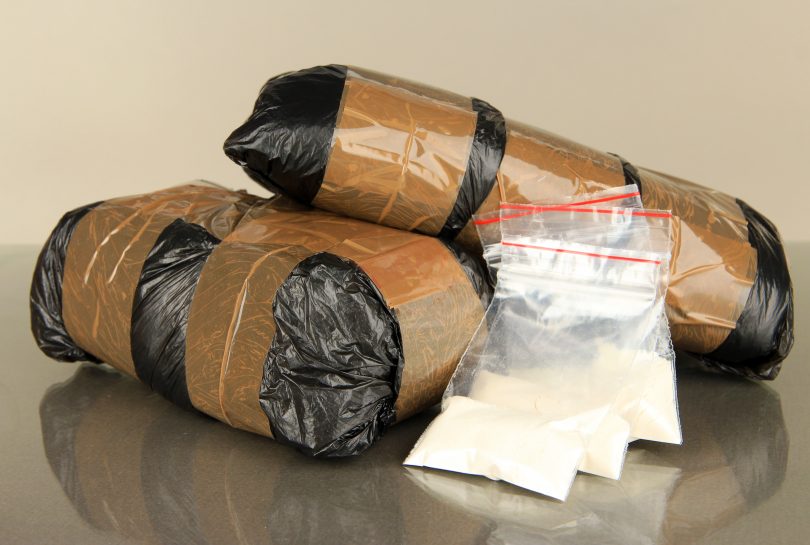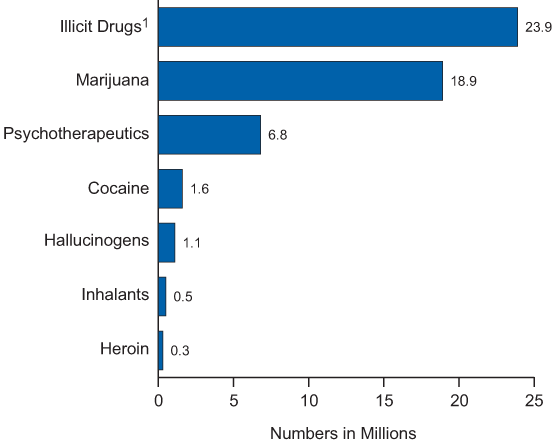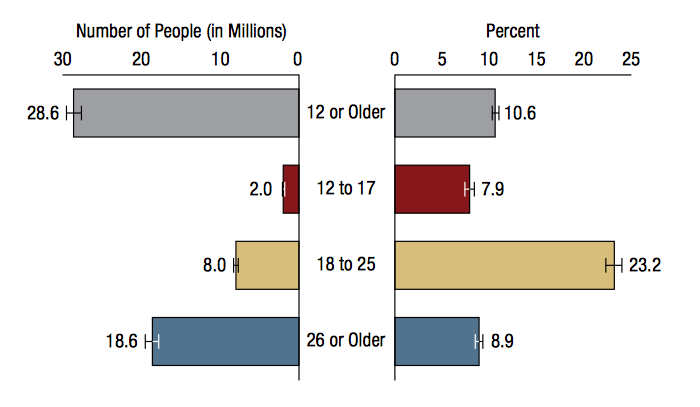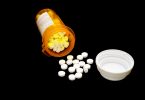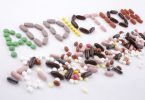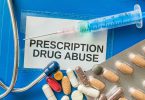There are individuals in every age group responsible for the high rate of drug consumption across the country. Here, we analyze nationwide drug use by age.
Illicit drug use has continued to grow, as illustrated by the following two charts, which show 23.9 million people had used illicit drugs within the previous month of the survey in 2012, and how that number had risen to 28.6 million people by 2016.
The above chart reflects information collected from the National Survey on Drug Use and Health in 2012. Illicit drugs are defined here as marijuana/hashish, cocaine (including crack), heroin, hallucinogens, inhalants, or prescription psychotherapeutics used recreationally.
This research indicates illicit drug usage in the previous month among people over the age of 11 years. The horizontal axis represents numbers in millions and the vertical axis represents seven drug categories: illicit drugs, marijuana, psychotherapeutics, cocaine, hallucinogens, inhalants, and heroin.
The second chart depicts similar drug categories with information collected in 2016. It brings to light that U.S. drug use at all ages is continuing to be of significant concern.
Some drug categories on this chart are combined with other drugs; Hashish was included with Marijuana and Crack was included with Cocaine.
Hallucinogens consisted of LSD, PCP, Peyote, Mescaline, Psilocybin, and MDMA while inhalants included Nitrous Oxide, Amyl Nitrite, cleaning fluids, gasoline, spray paint, glue, and miscellaneous aerosol sprays.
It’s important to note that the numbers of people referred to in these charts include people over the age of 11 in the civilian population of the United States who are not institutionalized.
This chart doesn’t include the sum total population for the country because the National Survey on Drug Use and Health doesn’t include children under the age of 12, homeless people that don’t reside in shelters, active-duty military personnel and those who reside in jails, prisons, nursing homes, mental health institutions or patients residing in hospitals for long-term care.
Another important aspect to consider is that these numbers aren’t mutually exclusive; it’s common for drug users of all ages nationwide to partake in the consumption of more than one illicit substance over the course of one month.
Age of Drug Users Nationwide
The highest rates of substance abuse occur as teens develop into adults. In 2014, 28.5 percent of binge drinkers were between the ages of 18 and 20, while 43.3 percent were aged between 21 and 25.
For the lower age group, about 1.3 million (5% of this group) juveniles struggled with substance addiction in 2014.
It breaks down into these age categories:
- 4% of 12 and 13 year olds
- 9% of 14 and 15 year olds
- 5% of 16 and 17 year olds
This table expresses age groups of drug users across the nation in numbers and percentages. The age group in gray indicates the drug consumption habits of people over the age of 11; the age group in red indicates those of individuals aged 12 to 17 years; the age group in yellow represents those of individuals aged 18 to 25 years; and the age group in blue illustrates the drug consumption habits of individuals over the age of 25.
About 14.5 million individuals fighting a substance abuse disorder are over the age of 25.
For example, the rate of illicit drug use in baby boomers (those born between 1946 and 1964) has consistently risen over the last 10 years, causing an increased number of hospital admissions related to drug-induced illnesses and overdoses.
The Wall Street Journal referred to this rise as a “Woodstock mentality” in which individuals feel compelled to relive their younger years, as they get older. It’s most common for those in this age group to drink alcohol and use marijuana in excess.
Drug Use by Age in the United States: Generations
Drug and alcohol abuse has been a concern in the U.S. for many generations. Below we explore trends in the age of U.S. drug users over the past year.
Alcohol
In the past year, more than 80 percent of individuals from the Depression Era, Baby Boomers, Gen X’ers, and Millennials, had consumed Alcohol at least one time in the previous year to their reporting. However, for each generation, the older they were, the less likely they were to consume alcohol.
Marijuana
Slightly more than 50 percent of all Baby Boomers had used Marijuana at least once in the previous year. The older they were, the less likely they were to have used it in the last 12 months.
In contrast, only about 10 percent of Depression Era individuals had used it within the past year, with approximately 30 percent of younger aged Gen X’ers and Millennials using it in the past year.
Prescription Opioids
Prescription painkillers are most likely to be used by Millennials with about 11 percent having used them within the past year.
Just over 5 percent of Gen X’ers and Baby Boomers used Prescription Opioids with Depression Era individuals reporting that less than 1 percent had used them in the last year.
Heroin
Baby Boomers are also most likely to abuse Heroin of the four generations discussed here, with 9 percent using Heroin in the past year. About 7 percent of Millennials and 5 percent of Gen X’ers have used it in the same time period.
According to the National Survey on Drug Use and Health, no individuals from the Depression era had used Heroin in the previous year before the survey.
Hallucinogens
Again, more Baby Boomers than any other generation had reported using Hallucinogens in the previous year before the survey – about 12 percent.
Less than 1 percent of individuals from the Depression era had used them within the previous year while Gen X’ers and Millennials had similar trends with about 8 percent of each generation admitting to Hallucinogen use within the past year.
This illustration of nationwide drug use by age and generation shows that many who need help with an addiction may have been born between the years 1946 and 1964.

